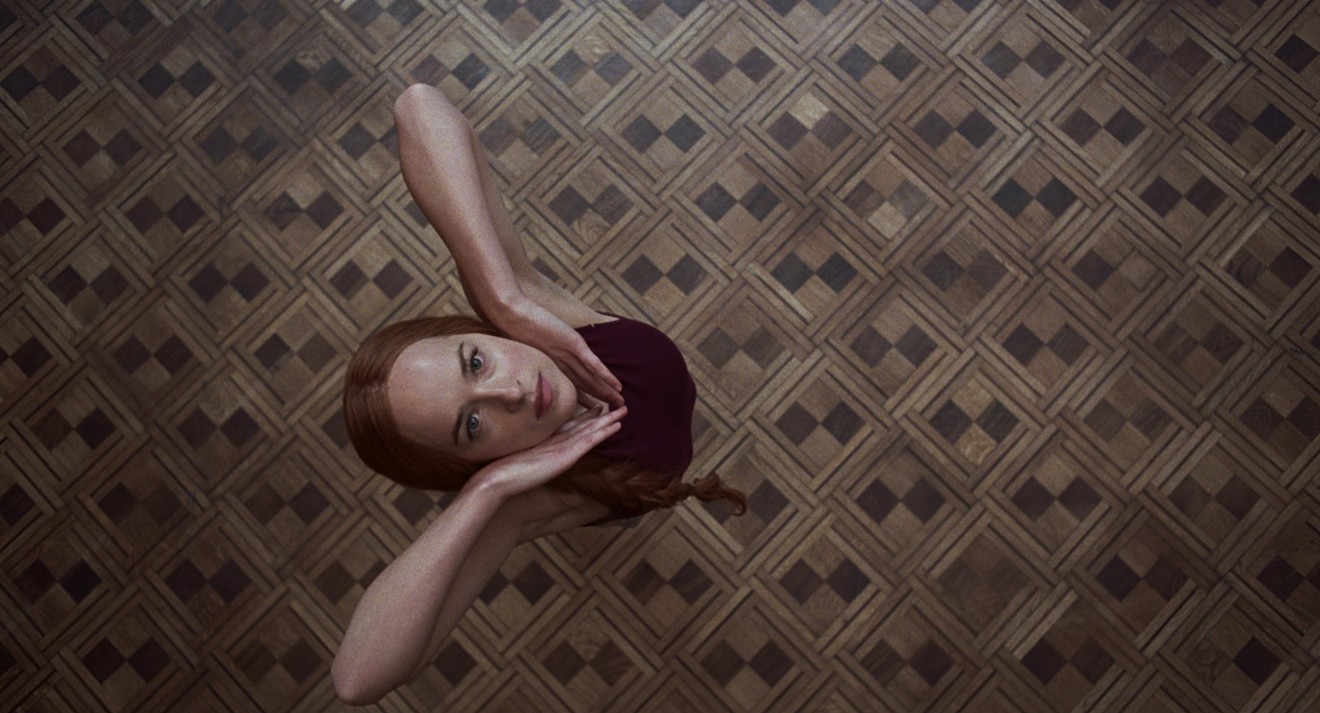A sure-fire way for a director to get me to tune out of a horror film is to over explain the origin of the movie’s evil entities. It’s the inexplicable and primal that are most thrilling, the abstract and destructive forces manifested in nightmares, the kinds of visions that vaporize just as you reach out to touch them, leaving the sense that something truly terrible happened, even if it was so fleeting it can’t be fully described. Dario Argento’s 1977 classic Suspiria exemplifies this. I cannot for the life of me recall the order of events in Argento’s movie, but individual moments, spanning a few short seconds to a couple of minutes, have left lasting impressions on me that still chill me today.
So I must say I was apprehensive about 2018’s Suspiria, Luca Guadagnino’s remake of Argento’s film, as too many horror classics — like The Fog or The Amityville Horror — have gotten sleeker, streamlined, modern, more conventional takes. But I’m happy to report that I have no idea what’s going on in Guadagnino’s Suspiria, and that’s wonderful. The two films function more as companion pieces than as mirrored twins, sharing only a few key details: There is a ballet school that is run by witches, and people are dying.
Other than that, the new version blazes its own path, which writer David Kajganich smartly intertwines with the politics of Cold War-era Germany. The film’s themes subtly remark on young people’s discontent with the past and the sins they were made to suffer for. There are some evergreen horror concepts, where the bare bones of the story are strong enough that they can be adapted and made over in multiple generations to express whatever fears and frustrations of the times in which they’re made. Invasion of the Body Snatchers is one of those, but maybe, just maybe, Suspiria could be another.
In this version, Dakota Johnson plays Susie Bannion, the name a homophone for the original’s protagonist Suzy Banyon. Susie arrives in Munich at a prestigious dance academy and pleads her way into getting an audition to join the company. She enters a spare, mirrored studio and whips her body around with such zealous purpose that it seems an act of sacrifice. She’ll hurt herself for her art. Her performance rouses the attention of the school’s master, Madame Blanc (Tilda Swinton), who senses Susie’s presence from another room. Meanwhile, an ominous, skinless figure lurks in the basement, a telltale heart whose blood gets pumping whenever Susie dances. We know Susie is special; we just don’t know how yet.
The women of the company welcome Susie, with the exception of a couple who seem psychologically scarred by the recent disappearance of one of the star dancers, Patricia (Chloë Grace Moretz). Madame Blanc and her witchy cohorts insist Patricia left of her own accord, but dancer Olga (Elena Fokina) lets everyone know she doesn’t buy it. Of course, Olga must be shut up or the school masters risk being exposed for whatever it is they’re doing at this school that makes young women disappear. But the manner in which Olga is punished is breathtakingly sick and gorgeous. I won’t spoil this scene, dear reader, but I will say that Fokina’s body movement and choreography in this moment unleash a torrent of anguished emotion and pain. Like great dance, it becomes an expression of the soul. The only thing worse than a gushing critic is a critic gushing pretentiously, but moments like these that remind me how vibrant and devastating art can be when it dares to go dark with abandon — this is some deep Hieronymus Bosch shit.
That’s not to say this film is some kind of flawless gift from the gods. But it is moving and mesmerizing, even in its clunkier non-sequitur montages of quick flashes of creepy objects and scenarios, some rip-offs of the work of the late artist Ana Mendieta, whose estate is now suing Guadagnino and Amazon. Personally, I hope the studio and filmmaker pay out to Mendieta’s estate and that the case drives hordes to this woman’s work. My biggest peeves with Suspiria — aside from a cloying, mismatched score — is that, like the new Halloween, it’s written, directed, scored, edited and shot by men, though it almost solely stars and concerns women.
Kajganich and Guadagnino did the work of consulting with women choreographers, because as Kajganich has said, they wanted the dance to be authentically “female,” and yet Damien Jalet, a man, was the choreographer. I love this movie, respect Guadagnino as a filmmaker and Kajganich as a writer, and yet I cannot shut up the part of my brain that screams that, yet again, men are coasting on the labor of women and co-opting women’s work as their own. I suspect this was done with ignorance rather than malice, but ignorance can no longer be wielded as a shield for criticism — get it together, guys. I’m so happy that Guadagnino’s Suspiria doesn’t seek to replace the original, and yet I am struck by how little has changed behind the camera since 1977. Here’s hoping the next iteration — and I hope there is one — changes that.
[
{
"name": "Air - MediumRectangle - Inline Content - Mobile Display Size",
"component": "18855504",
"insertPoint": "2",
"requiredCountToDisplay": "2"
},{
"name": "Editor Picks",
"component": "17105533",
"insertPoint": "4",
"requiredCountToDisplay": "1"
},{
"name": "Inline Links",
"component": "18349797",
"insertPoint": "8th",
"startingPoint": 8,
"requiredCountToDisplay": "7",
"maxInsertions": 25
},{
"name": "Air - MediumRectangle - Combo - Inline Content",
"component": "17105532",
"insertPoint": "8th",
"startingPoint": 8,
"requiredCountToDisplay": "7",
"maxInsertions": 25
},{
"name": "Inline Links",
"component": "18349797",
"insertPoint": "8th",
"startingPoint": 12,
"requiredCountToDisplay": "11",
"maxInsertions": 25
},{
"name": "Air - Leaderboard Tower - Combo - Inline Content",
"component": "17105535",
"insertPoint": "8th",
"startingPoint": 12,
"requiredCountToDisplay": "11",
"maxInsertions": 25
}
]











